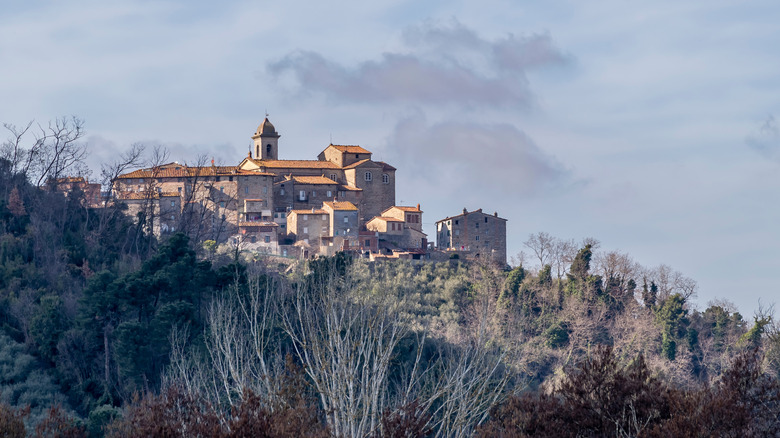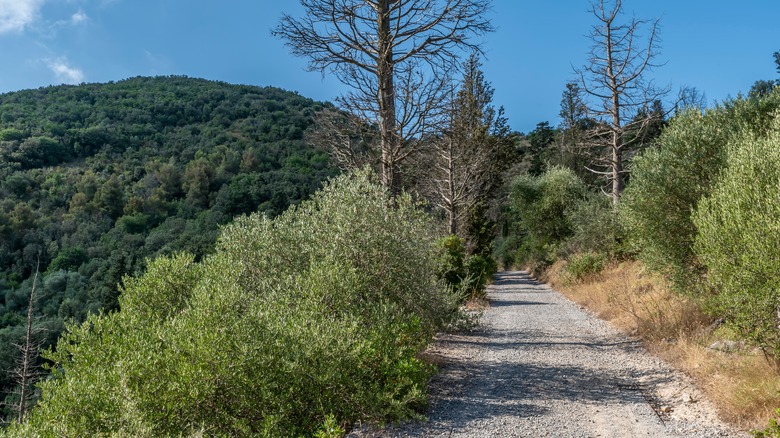Between Pisa And Florence Is Italy's Town With Sprawling Countryside, Wineries, And Charming Historic Villas
The very best destination for wine lovers in Italy, postcard-worthy landscapes peppered with slender Mediterranean cypresses, 2,500-plus hours of sunshine each year, the birthplace of the country's oldest pasta — the list of stuff that's going for Tuscany is long and tempting for the would-be traveler, there's no doubt about that. But it's often the more hidden, off-the-radar things that really make this corner of the Italian boot so enchanting. Just check out the town of Capannori.
It's sandwiched between the oft-visited cities of Florence, which counts around 3.8 million visitors each year, and Pisa, where the iconic leaning tower alone draws in 5 million people each year. There, it spreads across the hills to the southwest of Lucca — an ancient fortress town and Rick Steves' favorite place to bike in Italy — offering glimpses of handsome villas built by noble families way back when, along with elegant gardens, stirring churches, and access to wild mountain trails.
Sounds like the perfect thing? We thought it might. The bonus here is that Capannori is super-easy to get to. The international airport in Pisa is only a 30-minute drive to the southwest, while Florence's Amerigo Vespucci Airport is just 45 minutes away to the east. The main E76 highway also whizzes right through the middle of the area, connecting with the main roads of the Italian spine to make trips in from Rome possible in under four hours.
Majestic villas, wineries, and manicured gardens in Capannori
The grandly titled Villa Reale di Marlia reigns supreme among all the draws of Capannori. From 1806 onward, it was the home of Elisa Baciocchi Bonaparte (Napoleon Bonaparte's sister, no less), and now stands among the great noble residences of Italy. And that's saying something, because there are quite a few. While there's no denying the elegance of the Renaissance frontages and the Italianate terraces, the real enchantments come in the adjoining gardens. Flitting between citrus orchards and ornate water features, they create a plot of pure peace within the grounds.
The gardens of another Capannori villa, Villa Carrara, beckon some 20 minutes to the east. They host an altogether different type of monument: the great Oak of the Witches. This fabled tree is thought to be six centuries old, is designated as an official national monument of Italy, and comes steeped in folklore. Some say witches performed rites on its gnarled branches. Others say Carlo Collodi wrote chunks of his Pinocchio books while sitting beneath its boughs in the 1880s.
Capannori's opulent estates aren't just handsome reminders of the past. There are also more modern creations where you can go to sample the region's rich wines, created from the unique combination of cool mountain air and high sun coverage. Take Colle di Bordocheo, for example. An agriturismo and vineyard that specializes in organic wines, tasting sessions are set to a backdrop of the gorgeous Capannori backcountry.
Cranking up the adventure in Capannori
While the town of Capannori is seen as a bit of an outer-city district of Lucca itself, the greater area of Capannori spreads all the way into the surrounding hills and highlands. So, when you're done sipping fine wines and touring ostentatious villas, why not consider something a bit more adventurous?
The ancient route of the Via Francigena — the old pilgrimage path that linked Rome to England — still cuts through the town's center, passing directly below the parish church. You can also choose to diverge off that to take either a north or south extension, either of which link to some of the iconic historic villas and move through eye-wateringly wonderful Italian countryside in the process.
More serious trekking beckons further south of town, where routes weave into the wooded ridges of Monte Pisano. Even more serious trekking is on the table to the north, though. Drive just an hour that way and you'll find yourself in the highland retreat of Garfagnana, one of the gateways to the snow-capped Apuan Alps' most epic trails. There, routes pass through old marble quarries to soaring ridges that overlook the shimmering Ligurian Sea in the distance.


